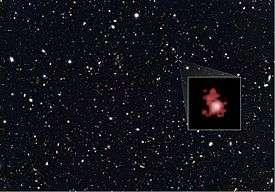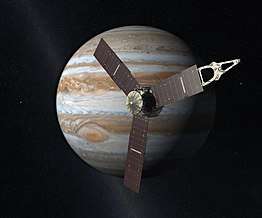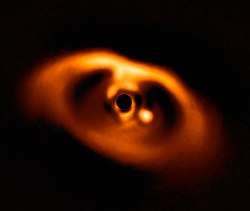K2-72e
K2-72e (also known by its EPIC designation EPIC 206209135.04), is a confirmed exoplanet, likely rocky, orbiting within the habitable zone of the red dwarf star K2-72, the outermost of four such planets discovered in the system by NASA's Kepler spacecraft on its "Second Light" mission. It is located about 227.7 light-years (69.8 parsecs, or nearly 2.1538×1015 km) away from Earth in the constellation of Aquarius. The exoplanet was found by using the transit method, in which the dimming effect that a planet causes as it crosses in front of its star is measured.
 Size comparison between K2-72e (left) and the Earth. | |
| Discovery | |
|---|---|
| Discovery site | Kepler Space Observatory |
| Discovery date | July 18, 2016[1] |
| Transit | |
| Orbital characteristics | |
| 0.2086 (± 0.0100)[1] AU | |
| Eccentricity | ~0 |
| 24.1699 (± 0.0059)[1] d | |
| Star | K2-72 |
| Physical characteristics | |
Mean radius | 0.82 (± 0.22)[1] R⊕ |
| Mass | 2.7+7.1 −1.5[2] M⊕ |
| Temperature | 280 K (7 °C; 44 °F) |
Characteristics
Mass, radius, and temperature
K2-72e is an Earth-sized exoplanet, meaning it has a mass and radius close to that of Earth. It has an equilibrium temperature of 289 K (16 °C; 61 °F). It has a radius of 1.29 R⊕.,[1] and a mass of 2.7 M⊕, depending on its composition.[2]
Host star
The planet orbits a (M-type) red dwarf star named K2-72, orbited by a total of three planets, of which K2-72e has the longest orbital period. The star has a mass of 0.21 M☉ and a radius of 0.23 R☉. It has a temperature of 3497 K and its age is unknown. In comparison, the Sun is 4.6 billion years old[3] and has a surface temperature of 5778 K.[4]
The star's apparent magnitude, or how bright it appears from Earth's perspective, is unknown.
Habitability
The exoplanet, along with K2-72c, were announced to be orbiting in the habitable zone of its parent star, the region where, with the correct conditions and atmospheric properties, liquid water may exist on the surface of the planet. K2-72e has a radius of 1.29 R⊕, so it is likely rocky. Its host star is a red dwarf, with about a fifth as much mass than the Sun does. As a result, stars like K2-72 have the ability to live up to 500–600 billion years, 40–50 times longer than the Sun will live.[5]
The planet is very likely tidally locked, with one side of its hemisphere permanently facing towards the star, while the opposite side shrouded in eternal darkness. However, between these two intense areas, there would be a sliver of habitability – called the terminator line, where the temperatures may be suitable (about 273 K (0 °C; 32 °F)) for liquid water to exist. Additionally, a much larger portion of the planet may be habitable if it supports a thick enough atmosphere to transfer heat to the side facing away from the star.
However, it receives 46% more sunlight than Earth does, so any oceans present would boil away, therefore possibly eliminating its habitability.
Discovery
The planet, along with the other three planets in the K2-72 system, were announced in mid-July 2016 as part of the new results from the second mission of the Kepler spacecraft.
References
- "NASA Exoplanet Archive". NASA Exoplanet Science Institute. 18 July 2016. Retrieved 2016-07-18.
- PHL's Exoplanets Catalog - Planetary Habitability Laboratory @ UPR Arecibo
- Fraser Cain (16 September 2008). "How Old is the Sun?". Universe Today. Retrieved 19 February 2011.
- Fraser Cain (15 September 2008). "Temperature of the Sun". Universe Today. Retrieved 19 February 2011.
- Adams, F. C.; P. Bodenheimer; G. Laughlin (2005). "M dwarfs: planet formation and long term evolution". Astronomische Nachrichten. 326 (10): 913–919. Bibcode:2005AN....326..913A. doi:10.1002/asna.200510440.



